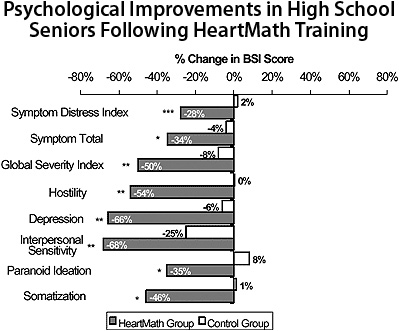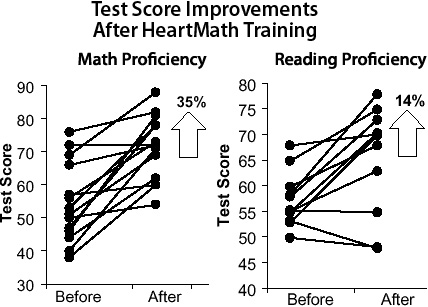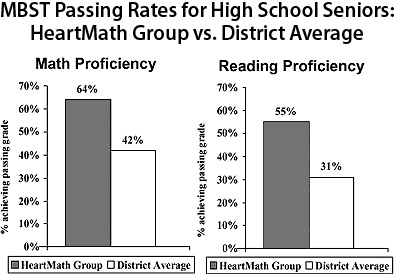Search Research Library:
Research Library
Publication
Improving Test‑Taking Skills & Academic Performance in High School Students Using HeartMath Learning Enhancement Tools
[]
Abstract
Summary
High school seniors who received a 3-week training in HeartMath learning enhancement skills demonstrated substantial improvements in test scores and passing rates on state-required Math and Reading tests. Students also experienced significant reductions in hostility, depression and other key indicators of psychological distress after learning HeartMath tools.
Background
In Minnesota, high school students must pass the state-required Minnesota Basic Standards Tests (MBST) in Reading and Math in order to graduate. Each year, a percentage of students do not receive their high school diploma because they fail to pass these exams. In some cases, the Basic Standards Tests represent a seemingly insurmountable challenge, with students having to re-take the tests up to seven or eight times in order to obtain a passing grade. Thus, these tests represent a significant source of stress and anxiety for many high school seniors.
Some teachers and school counselors in the Minneapolis Public School District had noted that test-taking anxiety appeared to be a major factor in keeping students from passing the Basic Standards Tests. Many students were so worried about passing, particularly in cases where they had already failed the tests, that they were unable to perform effectively, even if extremely well-prepared academically. Thus, in this study, the HeartMath self-management techniques were implemented as part of a Spring Training Camp designed to reduce test-taking anxiety and prepare students mentally and emotionally, as well as academically, for the state tests.
“Students had the knowledge, but were unable to perform on the tests because of anxiety and stress.”
Design
Twenty high school seniors who needed to re-take the MBST in Reading or Math enrolled in the Spring Training Camp. The program comprised 25 hours of instruction over 3 weeks’ time, including four 4-hour sessions conducted over Spring Break and five 2-hour after-school sessions both preceding and following Spring Break. The academic portion of the program utilized the same standardized curriculum that is used throughout the school district for state test preparation. In addition, about one-third of the time was spent teaching participants HeartMath tools as strategies to help them reduce their test-taking anxiety and improve performance. The students journaled daily, set goals for themselves and regularly practiced the Freeze-Frame and Heart Lock-In techniques. Participants also worked with the emWave® PC/Mac Emotional Management Enhancer (a computer-based performance enhancement system) to reinforce their use of the tools and to learn to self-generate states of increased physiological coherence, associated with improved emotional balance, mental clarity and cognitive performance. Students’ psychological well-being was assessed pre and post-intervention using the Brief Symptom Inventory (BSI), which measures key indicators of psychological distress.
Results
As compared to a control group that also completed the psychological assessment at the same time points, the HeartMath-trained students demonstrated significant improvements following the program. These included reductions in hostility, depression, interpersonal sensitivity (feelings of personal inadequacy, inferiority and self-doubt), paranoid ideation (fearfulness, suspiciousness and mistrust), somatization (physical symptoms due to stress) and global indices of distress (Figure 1).

Figure 1.
Psychological Improvements in High School Seniors Following HeartMath Training
Significant reductions in symptoms of psychological distress (Brief Symptom Inventory) experienced by HeartMath-trained students from pre to post- training, as compared to students in an untrained control group. Asterisks denote significant differences between the two groups in raw score means from time one to time two (three weeks later). *p < .05, **p < .01, ***p < .001.
Academic test results indicated that the emotional preparedness skills students learned in the Spring Training Camp resulted in test-taking performance improvements above and beyond those achieved through standard academic preparation alone. As shown in Figure 2, students in the program demonstrated a mean gain in their Math test scores of 35%. The mean gain in Reading was 14%. Several students were able to increase their test scores by more than 75% after the 3-week program.
“The students made gains that were significant, because they represented one to two years’ growth in reading or math with only one month of preparation and instruction. This clearly shows that in teaching students how to use the HeartMath tools, they were able to reduce their test-taking anxiety and more accurately show us what they know.”

Figure 2.
Test Score Improvements After HeartMath Training
Students’ mean scores on the Minnesota Basic Standards Tests before versus after HeartMath training. Students showed an average 35% improvement in Math and a 14% gain in Reading test scores after learning and practicing HeartMath tools for three weeks. As compared to district averages, these improvements represented one to two years’ growth in proficiency in both subjects.
Of the 20 students who participated, 13 (65%) passed one or both tests in April, 2000. Of those students taking the Math test, 64% passed, while 55% passed in Reading. Both of these passing rates were substantially above the district average for seniors re-taking the test in April; of those students district-wide who re-took the Math test, only 42% passed, and only 31% passed the Reading test (Figure 3). It should be emphasized that the HeartMath tools were the only difference in preparatory training received by the study group versus other students in the school district, as the same academic preparatory curriculum was utilized for all students re-taking the tests.

Figure 3.
MBST Passing Rates for High School Seniors – HeartMath Group vs. District Average
Percentage of HeartMath-trained students passing the Minnesota Basic Standards Tests in Math and Reading in April, 2000, as compared to the district average passing rate for all seniors retaking the tests at that same time.
Implications
This study’s results were particularly impressive to school administrators, given the magnitude of the changes attained after only a brief intervention. Study investigators noted that the 14% average gain in Reading scores achieved by students in the program after only 3 weeks of instruction was nearly double the improvement that the average student could expect to achieve over one year’s time with standard preparation. The 35% increase in students’ Math scores was even more notable, as there had been no substantial improvement in average performance on the Math test district-wide for the previous 3 years. Thus, the HeartMath group was the first student group to increase their scores considerably, and accomplished this with minimal instruction within a strikingly short time frame.
“If you can teach these kind of tools in three weeks with that powerful an effect, then teachers should be able to facilitate great strides in performance in very short periods of time — which is very important.”

